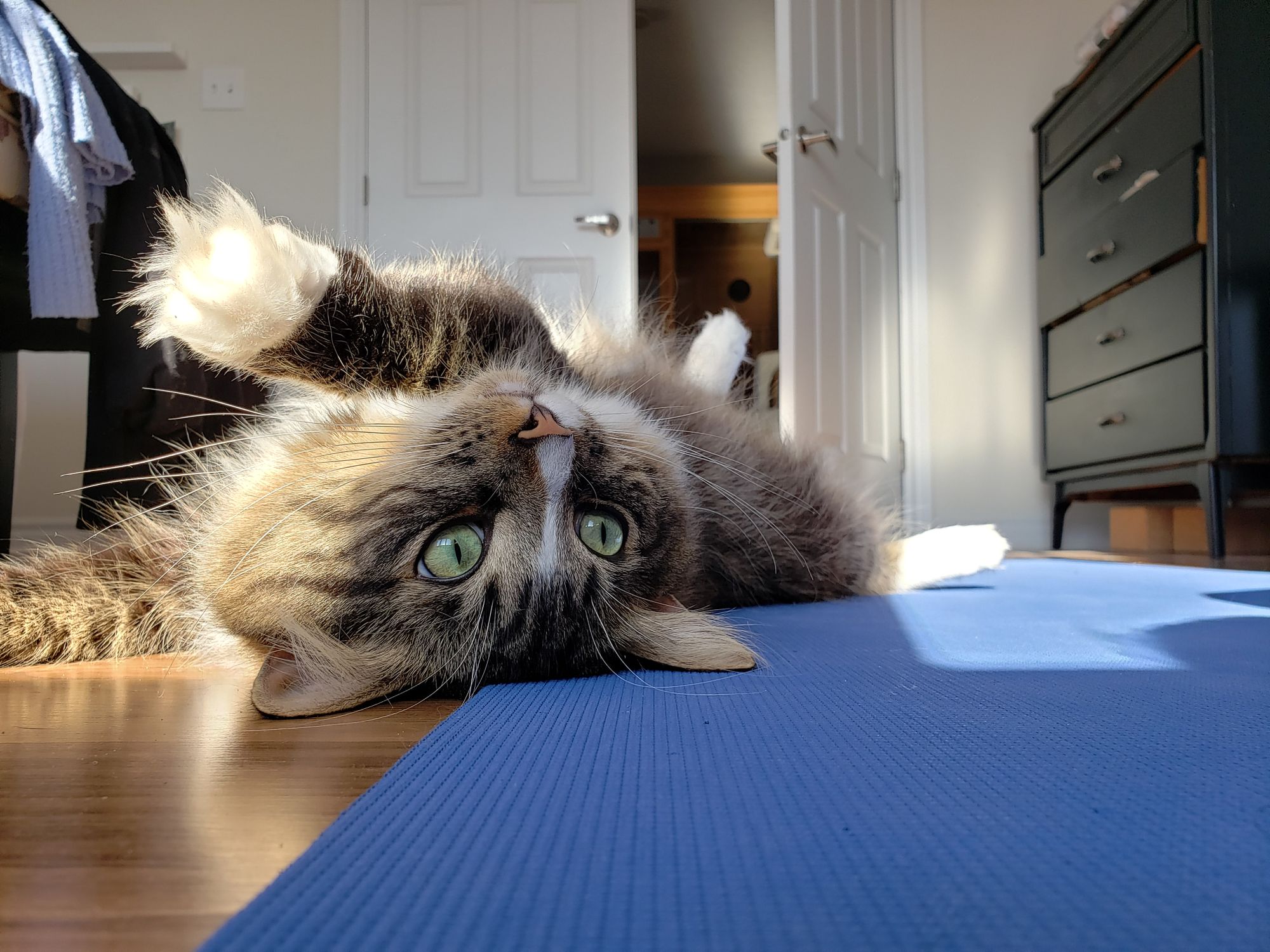Why Neglecting Thoracic Mobility Is a Bad Idea (3 Exercises You Need to Do)
You know hip mobility. The same goes for ankle mobility. But thoracic mobility? If you've never heard of it, start doing these 3 exercises ASAP.

Hip mobility. Ankle mobility. If you’re a long-time reader of the GymStreak blog (hi, friend!), then you’d know the importance of both for optimal lifting technique and injury prevention ?
But the truth is that these aren’t the only areas you should be paying attention to.
Um, yep. You’re about to learn another type of mobility work you should be adding to your training program: thoracic mobility. Not entirely sure where that region is on your body? Don’t worry.
That’s what this article is for. You’re going to find everything you need to know about thoracic mobility right here – from what it is to how to test your mobility in the region, and finally, to the best exercises to add to your routine if your mobility, well, sucks.
Let’s get right to it.
Thoracic mobility 101
A little anatomy lesson. The thoracic spine is the middle section of the vertebra between your neck and the lower back. And now, in English (we know, we know): in short, you can think of your thoracic spine as the "upper back".
So, thoracic mobility basically refers to the available movement or motion of your upper back. Thoracic mobility = “upper back mobility”.
You may be thinking … “But I don’t have a problem with my thoracic mobility?” Well, we’re not trying to be rude here, but you’re more likely than not – just like so many of us who’re working a desk job – to have limited thoracic mobility.
Unless you’re mindful of maintaining proper posture 24/7, you’re probably slumping all over the place (i.e., on the couch, in front of the desk, on the dinner table).
This perma-hunched-over posture can cause a weakening in the muscles of your upper back.
What’s wrong with poor thoracic mobility?
Meaning? You’ll find it increasingly challenging to “pull” your shoulders back into the optimal position, where they’re stacked vertically on top of your torso.
Limited thoracic mobility can then translate into issues with various movement mechanics:
- Thoracic rotation (i.e., twisting): This would be a problem if you take part in sports like golf, swimming, and tennis – among others.
- Wide-grip placement on barbells with back squats: Decreased thoracic mobility can make it much harder for you to “get under the bar” with a suitable hand-width placement that maximizes strength on the lift (because the weight is now further in front of you).
- Overhead lifting: Limited thoracic mobility decreases your range of shoulder movements, particularly elevation (e.g., on exercises like overhead press).
Beyond issues with sports and lifting performance, emerging research even goes as far as to suggest that limited thoracic mobility could lead to a dysfunctional breathing pattern.
See: normal breathing requires your ribs to lift to the sides – much like a bucket handle. But that can’t happen if your entire thoracic region is too stiff. And with less rib movement available, you’ll find it more challenging to meet your body's demands for oxygen in times of high exertion (i.e., you're just not able to breathe properly).
Go ahead – test your thoracic mobility!
Oh no. Sounds serious, doesn't it? But, of course, that's because it is – and you should test your thoracic mobility right now.
And the easiest way to do so is by performing an overhead squat. If you’re in the gym, you can use the barbell (make sure it’s unloaded); but if you’re currently still working out from home, feel free to substitute the barbell with a pole or a broomstick.
Take a video of you performing the overhead squat from the side. Observe your form at the bottom position.
If your thoracic mobility is fine, you should be able to get your arms into full flexion (180°; directly overhead of your shoulders) – while keeping the pelvis and lumbar spine neutral.
That means you shouldn’t look like you’re in anterior pelvic tilt, where your spine is hyperextended.
Struggling with that? Then you’re going to be interested in the following thoracic mobility exercises.
Best thoracic mobility exercises
Exercise 1: Cat-camel drill
The cat-camel drill – which, technically speaking, belongs in the "thoracic mobility stretches" category – is an excellent way to familiarize yourself with spinal extension, which is the direct opposite of what you're doing in a hunched-over position (i.e., spinal flexion).
To perform it:
- Get on your hands and knees on the mat, aligning your wrists underneath your shoulders and knees beneath your hips (quadruped position).
- Think of your spine as a straight line connecting the shoulders to the hips.
- Moving into the "camel" pose: inhale as you tilt your pelvis back so your tailbone sticks up. Press the chest towards the floor as you lift your head. Exhale.
- Moving into the “cat” pose: inhale as you round out your back and push your shoulder blades away from you. Your spine should form a “C” curve – much like an angry, hissing cat.
- Go through this cycle 10 times.
Exercise 2: Deep squat + thoracic rotation
The deep squat + thoracic rotation is one of the best thoracic mobility exercises you can do to reinforce proper upper back movement in a barbell back squat (plus, everything you learn is transferable to overhead lifts, too).
To perform it:
- Get into a deep bodyweight squat. Make sure your spine is in a neutral position.
- Grab your left foot with your right hand – then drop your right shoulder as far to the ground as possible while rotating your left arm up “towards the sky” (or, you know, towards the ceiling). Hold for 5 seconds.
- Do the same for the opposite side. So, grab your right foot with your left hand, etc.
- Perform 3 to 5 rotations to each side.
Exercise 3: Thoracic extension over foam roller
And finally … the last of the thoracic mobility exercises we’ll be covering in this article: the thoracic extension over foam roller. As with exercise #1, this will help stretch out your (often-times) overly tight chest muscles.
To perform it:
- Sit in front of your foam roller (positioned perpendicularly to your torso) and gently hammock the head with your hands – interlocking the fingers to support the weight of your head.
- Lean backward so that your upper back is reaching back over the foam roller.
- Gently allow your shoulders to reach the floor while the foam roller supports your upper back (note: the keyword here is “gently”!) Hold for a few seconds.
- Now, move the foam roller up an inch – and repeat the stretch.
- Carry on until you reach the top of your back. A word of caution: do not roll your neck over the foam roller! You could cause serious injury to yourself if you do.
Develop your body in a well-balanced manner
Ah, and there you have it: all the exercises that'll help with your thoracic mobility. As mentioned, one of the leading causes of your limited thoracic mobility is your poor, everyday posture.
But there's also another possible reason: you may be overtraining your chest. An overpowered chest can start pulling your entire shoulder region forward – causing the "hunched-back" posture you're so familiar with.
Thus, highlighting why you need to develop your muscle groups in a well-balanced way. And the only way to do that would be through a well-thought-out workout program.
Psst: GymStreak can help you with that if you don’t know the first thing about planning a workout routine that accounts for all the factors necessary for maximum muscle growth (e.g., training volume, periodization, and even exercise selection).
Get GymStreakReferences
Iqbal, M. (2016). PREVALENCE OF UPPER CROSS SYNDROME AMONG THE MEDICAL STUDENTS OF UNIVERSITY OF LAHORE.
Romberg, K., Fagevik Olsén, M., Kjellby-Wendt, G., Lofdahl Hallerman, K., & Danielsson, A. (2020). Thoracic mobility and its relation to pulmonary function and rib-cage deformity in patients with early onset idiopathic scoliosis: A long-term follow-up. Spine Deformity, 8(2), 257–268. https://doi.org/10.1007/s43390-019-00018-y
Waxenbaum, J. A., Reddy, V., & Futterman, B. (2021). Anatomy, Back, Thoracic Vertebrae. In StatPearls. StatPearls Publishing. http://www.ncbi.nlm.nih.gov/books/NBK459153/
Yang, S.-R., Kim, K., Park, S.-J., & Kim, K. (2015). The effect of thoracic spine mobilization and stabilization exercise on the muscular strength and flexibility of the trunk of chronic low back pain patients. Journal of Physical Therapy Science, 27(12), 3851–3854. https://doi.org/10.1589/jpts.27.3851

